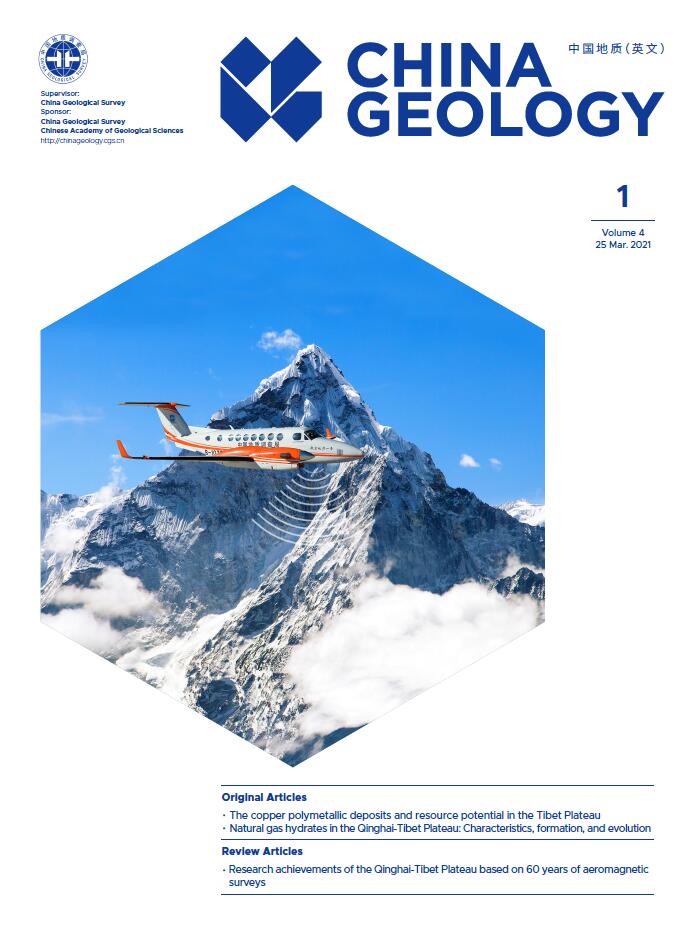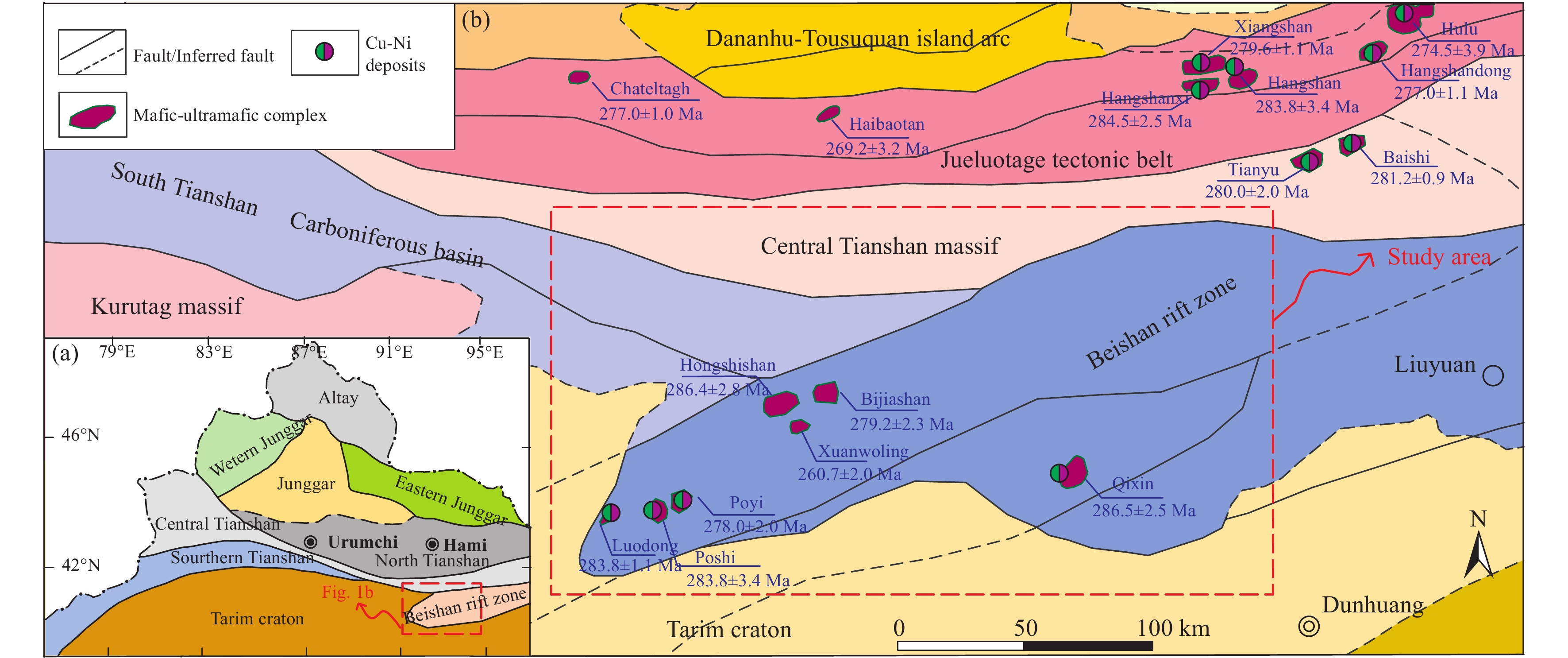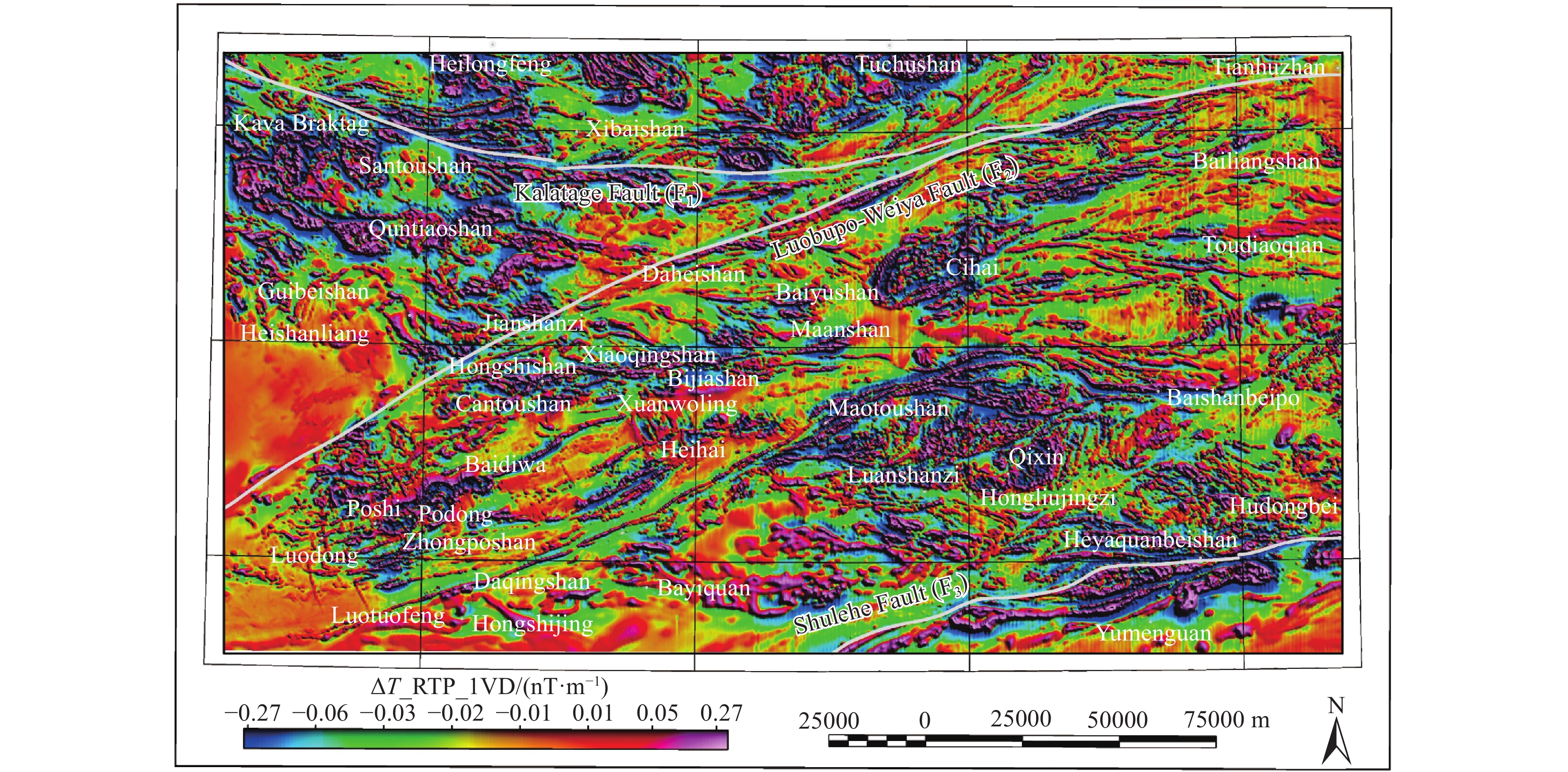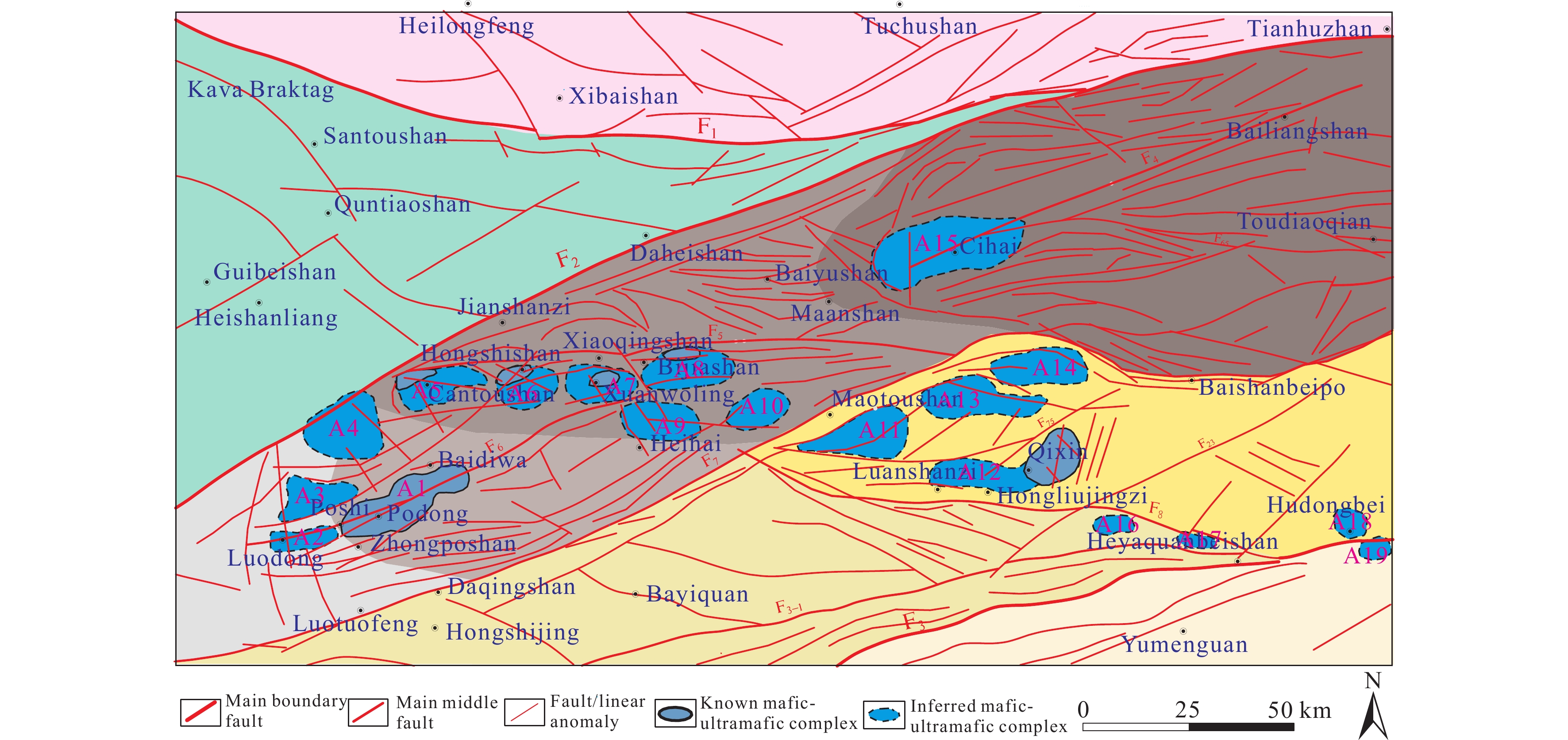| Citation: | Jing-zi He, Zheng-guo Fan, Sheng-qing Xiong, Teng-fei Ge, Xu-zhao Huang, Si-xun Wang, 2021. Geophysical prospecting of copper-nickel deposits in Beishan rift zone, Xinjiang, China Geology, 4, 126-146. doi: 10.31035/cg2021015 |
Geophysical prospecting of copper-nickel deposits in Beishan rift zone, Xinjiang
-
Abstract
The Beishan rift zone in Xinjiang Uygur Autonomous Region was formed due to strong activities of faults on the basement of the Tarim continental crust. Despite the fact that many geological research results of the rift zone have been achieved, only a few studies have been conducted on its regional geophysical characteristics. In this paper, the gravity and magnetic anomalies of the rift zone were highlighted through specific data processing of 1∶50000 high-precision aeromagnetic data and gravity data with a grid spacing of 2 km × 2 km. Based on this, the geophysical evidence for the scope and internal structures of the Beishan rift zone was obtained for the first time. The distinct characteristics of magnetic and gravity fields in the areas to the north and south of the Beishan rift zone reveal that deep faults exist between the Beishan rift zone and the geological units on the southern and northern sides. Furthermore, the faults on the two areas contain the bidirectional thrusts and have flower-shaped structures according to the characteristics of the magnetic and gravity fields. The Beishan rift zone can be divided into two tectonomagmatic zones, namely the Zhongposhan-Bijiashan-Cihai-Baishanliang zone (the northern zone) and the Bayiquan-Qixin-Baishan zone (the southern zone). The northern zone can be further subdivided into three comet-shaped anomaly groups (tectonomagmatic areas), while the southern zone can be further subdivided into two tectonomagmatic areas. According to the characteristics of aeromagnetic anomalies and gravity field, 19 mafic-ultramafic complexes were delineated. The known Pobei, Hongshishan, and Qixin complexes are all located within the inferred complexes,with estimates of total explored resources of Ni, Cu, and Au of 3×106 t, 10×103 t and 10 t, respectively. The prospecting of high-grade copper-nickel deposits should focus on the periphery and deep parts of the known and inferred mafic-ultramafic complexes. Among them, the peripheral strata of the complexes specifically have great prospecting potential of large-scale high-grade copper-nickel deposits of magma injection type. Finally, this paper analyzed the application effects of the rapid airborne-ground-drilling synergetic exploration method in the prospecting of copper-nickel deposits in Qixin, Beishan, Xinjiang, which will provide references for further exploration of copper-nickel deposits in Beishan area, Xinjiang.
-

-
References
Bai YL, Chen QL, Tang ZL, Fan YX, Jiang RF. 2004. The characteristics of basic-ultrabasic rocks in the back-arc rift system on the northeasyern margin of the Tarim plate. Geology in China, 31(3), 254–258 (in Chinese with English abstract). Beiki M, Clark DA, Austin JR, Foss CA. 2012. Estimating source location using normalized magnetic source strength calculated from magnetic gradient tensor data. Geophysics, 77(6), J23–J37. doi: 10.1190/geo2011-0437.1. Chai FM, Xia F, Chen B, Lu HF, Wang H, Li J, Yan YP. 2013. Platinum group elements geochemistry of two mafic-ultramafic intrusions in the Beishan block, Xinjiang, NW China. Acta Geologicia Sinica, 87(4), 474–485 (in Chinese with English abstract). Chen J, Xu YB, Wang F, Hao XJ, Yin CJ, Tian JT, Wang H, Zhang JR, Jia JD. 2013. Mafic-ultramafic nickel-copper metallogenic regularity of Xinjiang Pobei-Beacon Hill. Xinjiang Geology, 31(2), 184–189 (in Chinese with English abstract). Chen MJ. 1993. Structural styles of Turpan-Hami basin. Petroleum Exploration and Development, 20(5), 1–14 (in Chinese with English abstract). Cheng SD, Zhang XJ. 2000. Geotectonic division of Xinjiang. Xinjiang Geology, 18(4), 293–296 (in Chinese with English abstract). Clark DA. 2012. New methods for interpretation of magnetic vector and gradient tensor data I: Eigenvector analysis and the normalised source strength. Exploration Geophysics, 43(4), 267–282. doi: 10.1071/EG12020. Clark DA. 2013. New methods for interpretation of magnetic vector and gradient tensor data II: Application to the Mount Leyshon anomaly, Queensland, Australia. Exploration Geophysics, 44(2), 114–127. doi: 10.1071/EG12066. Feng J, Ruan BX, Deng G, Lü XB, Li FM, Wang H, Cao XF, Liu YR, Su QX, Wang YJ, Liu YG. 2014. Characteristics, metallogenic significance and tectonic setting of mafic-ultramafic intrusions in East Tianshan and Beishan. Xinjiang Geology, 32(1), 58–64 (in Chinese with English abstract). Gong QS, Liu MQ, Liang MH, Li HL. 2003. The tectonic facies and tectonic evolution of Beishan orogenic belt, Gansu. Northwestern Geology, 36(1), 11–17 (in Chinese with English abstract). Jiang CY, Cheng SL, Ye SF, Xia MZ, Jiang HB, Dai YC. 2006. Lithogeochemistry and petrogenesis of Zhongposhanbei mafic rock body, at Beishan region, Xinjiang. Acta Petrologica Sinica, 22(1), 115–126 (in Chinese with English abstract). Jiang HB, Yang HQ, Dong FC, Tan WJ, Zhao GB, Ren HN. 2012. Division of metallogenic unit in the East Tianshan-Beishan area. Northwestern Geology, 45(3), 1–12 (in Chinese with English abstract). Jiao JG, Leng X, Duan SS, Xia MZ, Rui HC, Tan L. 2018. Petrogenesis and metallogenic characteristics of the Early Permian Podong Cu-Ni sulfide deposit, northeastern margin of the Tarim plate. Acta Petrologica Sinica, 34(8), 2211–2222 (in Chinese with English abstract). Jiao JG, Rui HC, Xia MZ, Qian ZZ, Jin SF, Xu G, Chen BL, Duan SS. 2017. Practice of medium-large scale geological mapping for special issues in basic-ultrabasic intrusions: A case study of the Pobei intrusion in northeast Tarim Plate. Geological Bulletin of China, 36(11), 1999–2011 (in Chinese with English abstract). Li JY, Wang KZ, Sun GH, Mo SG, Li WQ, Yang TN, Gao LM. 2006. Paleozoic active margin slices in the southern Turfan-Hami basin: Geological records of subduction of the Paleo-Asian Ocean plate in central Asian regions. Acta Petrologica Sinica, 22(5), 1087–1102 (in Chinese with English abstract). Li WY, Niu YL, Zhang ZW, Zhang MJ, Gao YB, Hu PQ, Zhang JW, Tan WJ, Jiang HB. 2012. Geodynamic setting and further exploration of magmatis-related mineralization concentrated in the Late Paleozoic in the northern Xinjiang Autonomous Region. Earth Science Frontiers, 19(4), 41–50 (in Chinese with English abstract). Liu Y, Lü QT, Yan JY, Wu MA, Qi G, Deng Z. 2012. The structure of Luzong ore district and its metallogenic indication from gravity and magnetic information. Acta Petrologica Sinica, 28(10), 3125–3138 (in Chinese with English abstract). Lou DB, Sun Y, Shan CD, Sun J, Xiao KY. 2018. Geological characteristics and mineral prediction of Ni ore deposits in China. Earth Science Frontiers, 25(3), 067–081 (in Chinese with English abstract). doi: 10.13745/j.esf.2018.03.006. Lou DB, Wang DH, Xiao KY, Sun T, Wang QM, Yin JN. 2014. Prediction types and main successive strategic resource base area of Ni ore deposits in China. Geology in China, 41(3), 715–727 (in Chinese with English abstract). Lu HF, Wang H, Wang P, Deng G. 2016. Characteristics and potential forecast of ultramafic magmatite type Poyi Cu-Ni deposit in Ruoqiang of Xinjiang. Mineral Resources and Geology, 30(3), 316–323 (in Chinese with English abstract). Lu HF, Zhao XJ, Guo YM, Wang H, Wang P, Lin MM. 2012. The characteristic of Hongshishan nickel deposit in Xinjiang Beishan rift and its cause-multi-time rock magma mineralization. Xinjiang Geology, 30(2), 187–191 (in Chinese with English abstract). Lü LS, Liu j, Zhang ZH, Xie GQ. 2007. Temporal-spatial distribution and geodymanic settings of magmatic Ni-Cu-(PGE) sulfide deposits in China. Acta Petrologica Sinica, 23(10), 2561–2594 (in Chinese with English abstract). Mao JW, Pirajno F, Zhang ZH, Chai FM, Yang JM, Wu H, Chen SP, Cheng SL, Zhang CQ. 2006. Late Variscan Post collisional Cu-Ni sulfide deposits in East Tianshan and Altay in China principal characteristics and possible relationship with mantle plume. Acta Geological Sinica, 80(7), 925–942 (in Chinese with English abstract). Pan GT, Xiao QH, Lu SN, Deng JF, Feng YM, Zhang KX, Zhang ZY, Wang FG, Xing GF, Hao GJ, Feng YF. 2009. Subdivision of tectonic units in China. Geology in China, 36(1), 1–28 (in Chinese with English abstract). Qin KZ, Su BX, Sakyi PA, Tang DM, Li XH, Sun H, Xiao QH, Liu PP. 2011. SIMS Zircon U-Pb geochronology and Sr-Nd isotopes of Ni-Cu bearing mafic-ultramafic intrusions in Eastern Tianshan and Beishan in correlation with flood basalts in Tarim Basin (NW China). American Journal of Science, 311, 237–260. doi: 10.2475/03.2011.03. Qin KZ, Tang DM, Su BX, Mao YJ, Xue SC, Tian Y, Sun H, San JZ, Xiao QH, Deng G. 2012. The tectonic setting, style, basic feature, relative erosion deee, ore-bearing evaluation sign, potential analysis of mineralization of Cu-Ni-bearing Permian mafic-ultramafic complexes, Northern Xinjiang. Northwestern Geology, 45(4), 83–116 (in Chinese with English abstract). Song XY, Hu RZ, Chen LM. 2018. Characteristics and inspiration of the Ni-Cu sulfide deposits in China. Journal of Nanjing University (Natural Science), 54(2), 221–235 (in Chinese with English abstract). Su BX, Qin KZ, Sakyi P A, Li XH, Yang YH, Sun H, Tang DM, Liu PP, Xiao QH, Malaviarachchi SPK. 2011. U-Pb ages and Hf-O isotopes of zircons from Late Paleozoic mafic-ultramafic units in southern Central Asian Orogenic Belt. Gondwana Research, 20, 516–531. doi: 10.1016/j.gr.2010.11.015. Su BX, Qin KZ, Santosh M, Sun H, Tang DM. 2013. The Early Permian mafic-ultramafic complexes in the Beishan Terrane, NW China: Alaskan-type intrusives or rift cumulates? Journal of Asian Earth Sciences, 66, 175–187. doi: 10.1016/j.jseaes.2012.12.039. Su BX, Qin KZ, Sun H, Tang DM, Xiao QH, Cao MJ. 2009. Petrological and mineralogical characteristics of Hongshishan mafic-ultramafic complex in Beishan area, Xinjiang: Implications for assimilation and fractional crystallization. Acta Petrologica Sinica, 25(4), 873–887 (in Chinese with English abstract). Su BX, Qin KZ, Sun H, Wang H. 2010. Geochronological, petrological, mineralogical and geochemical studies of the Xuanwoling mafic-ultramafic intrusion in Beishan area, Xinjiang. Acta Petrologica Sinica, 26(11), 3283–3294 (in Chinese with English abstract). Sun T, Qian ZZ, Deng YF, Li CS, Song XY, Tang QY. 2013. PGE and isotope (Hf-Sr-Nd-Pb) constraints on the origin of the Huangshandong magmatic Ni-Cu sulfide deposit in the entral Asian orogenic belt, northwestern China. Economic Geology, 108, 1849–1864. doi: 10.2113/econgeo.108.8.1849. Tang QY, Zhang MJ, Li WY, Yu M, Zhang ZW, Wang Y. 2015. Geodynamic setting and metallogenic potential of Permian large-sized mafic-ultramafic intrusions in Beishan area, Xinjiang, China. Geology in China, 42(3), 468–481 (in Chinese with English abstract). Teng JW, Yang LQ, Yao JQ, Liu HC, Liu C, Han LG, Zhang XM. 2007. Deep disscover ore exploration and exploitation for metal mineral resocres and its deep dynamical process of formation. Progress in Geophysics, 22(2), 317–334 (in Chinese with English abstract). Wang H, Wang P, Li J, Feng J, Deng G, Lü XB. 2015. A tentative discussion on features of mafic-ultramafic rocks and exploration methods in Pobei area of Ruoqiang, Xinjang. Geology in China, 42(3), 777–784 (in Chinese with English abstract). Wang MC, Zhang B, Li WC, Cui JG, Liang QF, Wang XP, Du SX, Wang BY. 2007. The rift evolution and metallogenic regularities of gold ores of the Western part of Beishan in Xinjiang. Northwestern Geology, 40(2), 71–76 (in Chinese with English abstract). Wilson H. 1985. Analysis of the magnetic gradient tensor. Defence Research Establishment Pacific: Canada Technical Memorandum, 85, 13–47. Xia ZD, Xia MZ, Wang Y, Jiang CY, Ling JL. 2012. Geochemical characters and petrogenesis of the Bijiashandong basic-ultrabasic intrusion, NE Tarim Plate. Geological Science and Technology Information, 31(2), 1–12 (in Chinese with English abstract). Xie W, Song XY, Nie XY, Cheng SL. 2011. Features of the mantle source and tectonic setting of the Poshi Ni-Cu sulfide-bearing intrusion, Xinjiang, China. Earth Science Frontiers, 18(3), 189–200 (in Chinese with English abstract). Xie X, Li WM, Sun JM, Li J, Huang M. 2018. Geochemistry and zircon U-Pb dating of the Baishan mafic-ultramafic rock complex in the Beishan area of Xinjiang and its prospecting significance. Geological Science and Technology Information, 37(6), 11–21 (in Chinese with English abstract). Xue SC, Li CS, Wang QF, Ripley EM, Yao ZS. 2019. Geochronology, petrology and Sr-Nd-Hf-S isotope geochemistry of the newly-discovered Qixin magmatic Ni-Cu sulfide prospect, southern Central Asian Orogenic Belt, NW China. Ore Geology Reviews, 111, 1–18. doi: 10.1016/j.oregeorev.2019.103002. Xue SC, Qin K, Li CS, Tang DM, Mao YJ, Qi L, Ripley EM. 2016. Geochronological, petrological, and geochemical constraints on Ni- Cu sulfide mineralization in the Poyi ultramafic-troctolitic intrusion in the Northeast Rim of the Tarim Craton, western China. Economic Geology, 111(6), 1465–1484. doi: 10.2113/econgeo.111.6.1465. Yang JQ, Zhong L, Deng G. 2002. Metallogenic prognosis and prospecting targets of Pobei basic-ultrabasic rock bodies 1 and 10 in Beishan area. Xinjiang Geology, 20(3), 216–218 (in Chinese with English abstract). Yao ZS, Qin KZ. 2014. Geophysical exploration for magmatic Cu-Ni sulfide deposits in the orogenic belt: Current status, problems and vistas. Progress in Geophysics, 29(6), 2800–2817 (in Chinese with English abstract). doi: 10.6038/pg20140649. Zhang DR. 2000. Characteristics of geophysical field and properties of basement in Beishan area. Geophysical and Geochemical Exploration, 24(2), 87–98 (in Chinese with English abstract). Zhang WS. 1992. Geotectonics and evolution characteristics of Beishan, Xinjiang. Xinjiang Geology, 10(2), 129–137 (in Chinese with English abstract). Zhao WZ, Yuan F, Zeng XM. 1992. The structural characteristics of Turpan-Hami basin. Acta Petrolei Sinica, 13(3), 9–18 (in Chinese with English abstract). Zhou JY, Cui BF, Xiao HL, Chen SZ. 2000. The rift evolution and Au ore forming regular in East part of Beishan, Gansu and Xinjiang. Volcanology and Mineral Resources, 21(1), 7–16 (in Chinese with English abstract). -
Access History

-
Figure 1.
a–Map of regional location of the study area (modified from Sun T et al., 2013); b–sketch map of geotectonics and distribution of mafic-ultramafic complexes in Eastern Tianshan-Beishan region (modified from Su BX et al., 2013).
-
Figure 2.
Bouguer gravity anomaly map (a) and aeromagnetic ΔT anomaly map (b) of Beishan area, Xinjiang.
-
Figure 3.
RTP aeromagnetic anomaly ΔT map of Beishan area, Xinjiang.
-
Figure 4.
Aeromagnetic NSS anomaly map of Beishan area, Xinjiang.
-
Figure 5.
Residual Bouguer gravity anomaly map of Beishan area, Xinjiang.
-
Figure 6.
Map of Bouguer gravity anomalies at different upward continuation heights in Beishan area, Xinjiang.
-
Figure 7.
First vertical derivative map of Bouguer gravityanomalies in Beishan area, Xinjiang.
-
Figure 8.
Map of RTP aeromagnetic ΔT anomalies at different upward continuation heights in Beishan area, Xinjiang.
-
Figure 9.
First vertical derivative map of RTP aeromagnetic ΔT anomalies in Beishan area, Xinjiang.
-
Figure 10.
Distribution of faults and mafic-ultramafic complexes inferred from gravity and magnetic data in Beishan area, Xinjiang.
-
Figure 11.
Characteristics of geology and gravity and magnetic anomalies of Pobei complex. a–geological map (modified from Jiao JG et al., 2017); b–vertical first-order derivation of Bouguer gravity anomalies; c–aeromagnetic ΔT anomalies; d–RTP aeromagnetic ΔT anomalies; e–vertical first-order derivation of RTP aeromagnetic ΔT anomalies; f–RTP aeromagnetic ΔT anomalies at an upward continuation height of 1 km.
-
Figure 12.
Exploration results of concealed high-grade copper-nickel deposits in Qixin, Xinjiang. a–RTP residual aeromagnetic anomalies after high-pass filtering (cut-off wavelength: 800 m); b–residual Bouguer-gravity anomalies after high-pass filtering (cut-off wavelength: 800 m); c–electromagnetic anomalies of the first 10 traces obtained from ATEM survey; d–inversion results of apparent resistivity of line AB; e–drilling results





 DownLoad:
DownLoad:










